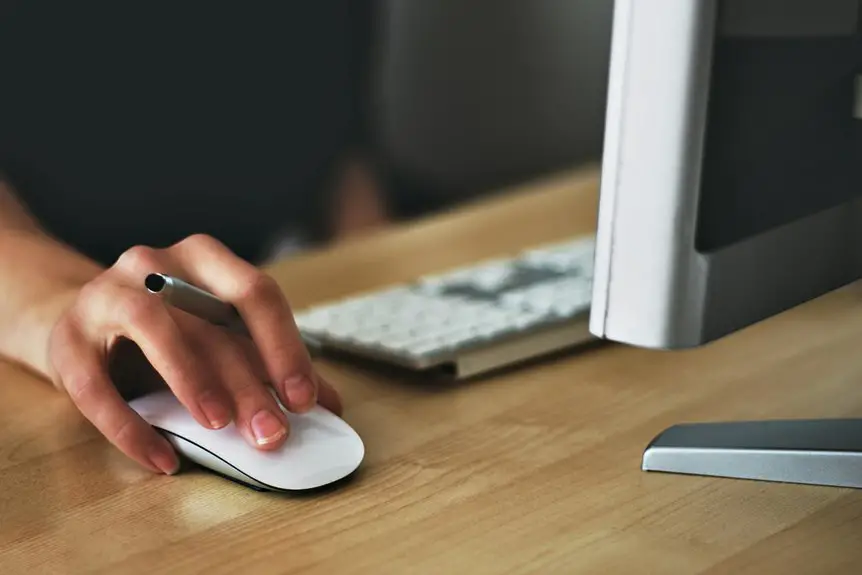Choosing the right mouse size for your hand isn't just about preference; it's crucial for comfort and efficiency. If you've ever felt strain or discomfort during long computer sessions, you might want to reassess your mouse choice. Measuring your hand and understanding grip styles can lead you to a better fit. Let's explore how to find that perfect match and improve your overall experience.
Table of Contents
Key Takeaways
- Measure your hand length and width to determine your size category: Small, Medium, Large, or Extra Large.
- Choose a mouse that fits your grip style: palm, claw, or fingertip, as each requires different dimensions.
- Opt for ergonomic designs to enhance comfort and reduce strain during prolonged computer use.
- Test different mouse sizes in-store or borrow from friends to assess comfort and responsiveness before purchasing.
- Consider your primary tasks; gaming mice may vary in size to accommodate different hand sizes and grips for improved control.
Understanding Hand Sizes and Mouse Dimensions
When it comes to choosing the right mouse, understanding your hand size and the mouse dimensions is crucial. A mouse that fits your hand properly enhances comfort and improves your overall computing experience.
If your hand is small, you'll want a compact mouse that allows for easy grip and control. Conversely, if you have larger hands, a bigger mouse with ample surface area can prevent discomfort during long usage sessions.
Pay attention to the mouse's length, width, and height, as these dimensions can greatly affect your grip style—whether you're a palm, claw, or fingertip gripper.
Finding the right balance between your hand size and the mouse dimensions will lead to better precision and less strain while you work or game.
How to Measure Your Hand for the Perfect Fit
To find the perfect mouse for your hand, start by measuring your hand length from the tip of your middle finger to the base of your palm.
Next, measure your hand width across the widest part, which will help you understand the overall size you need.
Don't forget to consider your grip style, as it can influence how the mouse feels in your hand.
Measuring Hand Length
Measuring your hand length is crucial for finding a mouse that fits just right. To get an accurate measurement, extend your dominant hand flat and use a ruler or measuring tape. Measure from the tip of your longest finger down to the base of your palm. This measurement will help you choose a mouse that feels comfortable during use.
| Measurement Type | Measurement (inches) | Recommended Mouse Size |
|---|---|---|
| Small | 6.5 or less | Small |
| Medium | 6.5 – 7.5 | Medium |
| Large | 7.5 or more | Large |
| Extra Large | 8.5 or more | Extra Large |
| Unisex | All sizes | Varies |
This information will guide you in selecting the perfect fit!
Determining Hand Width
Understanding your hand width is essential for selecting a mouse that feels comfortable in your grip. To measure your hand width, lay your hand flat on a surface with your fingers extended.
Use a ruler or tape measure to find the widest part of your hand, typically across the knuckles. Make sure to measure from the outer edge of your pinky to the outer edge of your thumb.
Take note of this measurement in inches or centimeters. By knowing your hand width, you can compare it to the specifications of different mice.
Finding the right fit can significantly enhance your comfort and efficiency during use. Remember, a proper fit helps prevent strain and allows for smoother movements.
Considering Grip Style
How do you typically hold your mouse? Your grip style significantly impacts the size and shape of the mouse you need.
There are three common grip styles: palm, claw, and fingertip. If you use a palm grip, you'll want a larger mouse that allows your entire hand to rest comfortably.
For claw grips, a medium-sized mouse with a more contoured shape works best, as it supports your fingers while keeping your palm elevated.
If you prefer fingertip grip, a smaller mouse fits snugly in your hand, allowing for quick, precise movements.
To find the perfect fit, measure your hand while in your preferred grip position and compare it with the dimensions of potential mice. This way, you'll ensure comfort and efficiency.
Types of Mice and Their Size Variations
When choosing a mouse, you'll notice various types that cater to different needs and preferences.
Ergonomic and standard mice come in different sizes, while gaming mice often have specific dimensions for optimal performance.
If you're frequently on the go, travel-friendly mouse sizes can make a big difference in your comfort and convenience.
Ergonomic vs. Standard Mice
While both ergonomic and standard mice serve the same basic function, their designs cater to different needs and preferences. Ergonomic mice are shaped to fit the natural contour of your hand, reducing strain during prolonged use. Standard mice, on the other hand, often have a more traditional design that some users may find comfortable.
Here's a quick comparison to help you decide:
| Feature | Ergonomic Mouse | Standard Mouse |
|---|---|---|
| Design | Contoured for comfort | Flat and symmetrical |
| Hand Position | Neutral wrist position | May cause wrist strain |
| Ideal Use | Long hours of use | Casual use |
| Price Range | Generally higher | Generally lower |
| Customization | Often includes extras | Limited customization |
Choose based on your needs!
Gaming Mouse Dimensions
Choosing the right gaming mouse size can significantly enhance your gaming experience, as each type of mouse comes in various dimensions to suit different hand sizes and grip styles.
Generally, gaming mice fall into three categories: small, medium, and large. If you have smaller hands, a compact mouse will allow for better control and quicker movements. For medium-sized hands, a standard mouse strikes a balance between comfort and performance. Larger hands may benefit from a bigger mouse, providing a more natural grip.
Also, consider your grip style—palm, claw, or fingertip—since it influences how the mouse feels in your hand. Ultimately, finding the right dimensions tailored to your needs will elevate your gameplay and reduce discomfort during extended sessions.
Travel-Friendly Mouse Sizes
How do you find a travel-friendly mouse that meets your needs? When you're on the go, a compact and lightweight mouse is essential.
Look for models labeled as portable or mini, which typically range from 3 to 4 inches in length. These sizes fit comfortably in your hand while easily slipping into your laptop bag.
Wireless options can also simplify your setup, eliminating tangled cords. Consider ergonomic designs, too; even small mice can offer comfort for extended use.
Brands often provide travel-specific versions of their popular models, ensuring you don't have to sacrifice performance for portability.
Ultimately, the right travel-friendly mouse balances size, weight, and functionality, making your mobile work experience seamless. Choose wisely!
Ergonomics: The Importance of Comfort and Support
When selecting a mouse, prioritizing ergonomics can greatly enhance your comfort and support during long hours of use. A well-designed mouse fits your hand naturally, minimizing strain on your wrist and fingers.
You should look for features like a contoured shape that aligns with your grip and a thumb rest that reduces fatigue. Adjustable sensitivity settings can also help, allowing you to find the perfect balance for your tasks.
Investing in an ergonomic mouse can prevent discomfort and long-term issues like repetitive strain injuries. Remember, comfort is key; when you feel good using your mouse, you'll work more efficiently and stay focused longer.
Don't underestimate the impact of a good mouse on your overall productivity and well-being.
Personal Preferences: Grip Styles and Usage Scenarios
What grip style do you prefer? Your choice can significantly impact your comfort and performance.
If you lean towards a palm grip, you'll want a larger mouse that supports your entire hand. For a claw grip, a smaller, more contoured design helps you maintain control while keeping your fingers arched. If fingertip grip is your go-to, seek a lightweight mouse that allows for quick, precise movements.
Consider your usage scenarios too. Gamers often benefit from a responsive, agile mouse, while those working long hours might prioritize comfort.
Think about how you use your mouse daily. Your grip style and the tasks you tackle will guide you toward finding the perfect size that feels just right in your hand.
Trying Before Buying: Testing Mouse Size in Action
Finding the right mouse size isn't just about knowing your grip style; it's also about experiencing how it feels in action. When you can, try out different mice in-store or borrow from friends. Pay attention to comfort, control, and responsiveness during your tests.
Here's a quick comparison to consider:
| Mouse Type | Size Category | Ideal Grip Style |
|---|---|---|
| Compact Mouse | Small | Fingertip Grip |
| Standard Mouse | Medium | Palm Grip |
| Gaming Mouse | Large | Claw Grip |
Frequently Asked Questions
Does Mouse Size Affect Gaming Performance Significantly?
Yes, mouse size can significantly affect your gaming performance. If it doesn't fit your hand well, you might struggle with control and precision. Finding the right size improves comfort, responsiveness, and overall gameplay experience.
Are There Universal Mouse Sizes for All Hand Shapes?
There aren't universal mouse sizes that fit all hand shapes. Everyone's unique, and what feels comfortable for you might not work for someone else. It's best to try different sizes to see what suits you.
Can a Smaller Mouse Cause Hand Pain Over Time?
Yes, a smaller mouse can lead to hand pain over time. When your hand isn't properly supported, it strains muscles and tendons. It's essential to choose a mouse size that fits comfortably in your hand.
How Often Should I Replace My Mouse Based on Size?
You should replace your mouse whenever you notice discomfort, wear, or decreased performance. Regularly assess how it feels in your hand; if it's not comfortable anymore, it's time for an upgrade.
Does Mouse Weight Matter When Considering Size?
Mouse weight definitely matters when you're considering comfort and control. A heavier mouse can provide stability, while a lighter one allows for quicker movements. It's all about finding what feels right for your gaming or work style.




